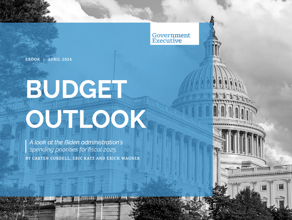Can Biden Deliver Better ‘Customer Experience’ for Americans Than His Predecessors?
He is now the fifth president since Bill Clinton to announce a new customer focus for federal services.
The Biden Administration has announced a new “Customer Experience and Service Delivery” initiative, promising some pretty specific and measurable actions, not just high-minded rhetoric. For example, it includes 36 customer experience commitments across 17 federal agencies focused on “the moments that matter most in people’s lives” such as retiring, travelling, and paying for college. It also focuses on reducing administrative burdens for people applying for safety net programs by streamlining enrollment and certification processes.
But is this just new wine in old wine skins, or is it a strategic renewal and expansion?
Biden is now the fifth president since Bill Clinton to announce a new customer focus for federal services. It started with an executive order in 1993 by Clinton, who made customer service the signature focus of his Reinventing Government initiative. (Full disclosure, I was a deputy director for that initiative.) But the Biden initiative builds on—and takes lessons from—his predecessors.
Lessons from the Past
Over the past 30 years, presidents have undertaken customer-oriented initiatives to improve federal services to the public with an eye towards improving trust in the government’s ability to deliver on its promises. Here are highlights from some of these initiatives, and lessons learned (and here’s more history from a prior post):
President Clinton. His administration’s reinventing government initiative, under the direction of Vice President Al Gore, undertook a number of customer-oriented initiatives via executive orders and memos. It declared “The standard of quality shall be equal to the best in business.” This resulted in setting 4,000 service standards across 570 agencies. It worked with the publishers of 6,000 phone directories across the country to create customer-oriented Blue Pages where you could find Passports under “P,” not under “S” for State Department, which issues passports—this was before Google or USA.gov existed.
In its later years, it shifted to the use of customer satisfaction surveys and focused attention on 32 agencies that had the most interaction with the public, such as the Postal Service and IRS. And since this was during the early years of the internet, it sponsored the creation of new websites organized around target populations—business.gov, students.gov, recreation.gov, etc. It also promoted the creation of FirstGov.gov, the first one-stop site for the federal government (re-named under Bush as USA.gov).
Lesson: Creating a targeted focus on a subset of services leads to more tangible results.
President George W. Bush. The Bush administration deemphasized customer service, largely because it was seen as a Clinton initiative. But they didn’t eliminate it. The Bush team changed the language to focus on “citizen” services, with an emphasis on electronic service delivery. In his e-government initiatives, the focus was on selected citizen services, including electronic EZ tax filing, seeking help after a disaster (now disasterassistance.gov), and accessing federal benefits (now benefits.gov). These and other digital initiatives are expanded on through Biden’s new directive. The efforts to measure and publicize customer satisfaction was deemphasized, which led to calls on Capitol Hill for legislative action but this never resulted in anything.
Lesson: Moving to digital e-gov can make a big difference for public ease of access at a lower cost than in-person services.
President Obama. The Obama administration created a new emphasis, with a new directive that agencies create customer service plans, but was slow to operationalize actions in his first term. In his second term, he created a “cross-agency priority goal” that focused on a subset of 30 services in 16 agencies that were seen as “high touch.” His administration incorporated the newest private sector best practice—customer experience—which focused not on specific transactions but on the “journey” that a customer would face in receiving services. They also created a cross-agency Core Federal Services Council and an awards program to champion improved customer experience within the federal community.
Probably the most prominent, and successful, efforts were at the Department of Veterans Affairs. VA secretary Bob McDonald created a Veterans Experience Office in 2016 in response to the Phoenix hospital waiting list scandal, which was a wake-up call that there was no “customer voice” in the system to understand what was going on in the different VA bureaus. This office led a redesign of how VA delivered services. For example, it championed the creation of a “patient experience program” based on human-centered design, using journey mapping. It started with hospital appointment scheduling to identify “moments that matter” in the process. The office reported that it increased veterans’ trust in VA by 25% over the subsequent 5-year period using this “bottom up” approach.
Lesson: Focusing on designing service delivery from the perspective of an individual customer’s experience is critical to success.
President Trump. The Trump administration placed no real emphasis on customers in public statements and disbanded the Obama-created cross-agency council of career leaders and awards program. However, Trump did quietly continue the customer experience efforts begun under President Obama via a cross-agency priority goal that focused on a handful of 26 “high impact service providers.” A new cross-agency network evolved and a presidential-level awards recognition program was reinstituted. But more importantly, the Trump administration invested in staffing, digital services, and support structures at the General Services Administration and the U.S. Digital Service.
Lesson: Building governmentwide administrative and technical capacity matters.
Applying the Lessons
So what’s different this time? The new Biden initiative has taken to heart lessons from previous administrations in designing its new initiative.
- The directive sets clear, measurable expectations of what is to be delivered and how. The Biden directive creates clear expectations of what people can expect in each of the 36 initiatives detailed. For example: “The Secretary of State shall design and deliver a new online passport renewal experience that does not require any physical documents to be mailed.”
- It focuses on organizing around “life experiences” using industry best practices such as “journey mapping” and “human-centered design.” This strategy will integrate activities that may involve a subset of services from several agencies—such as Defense, Veterans Affairs, and Labor—when military personnel transition from active duty to private life.
- A parallel strategy focuses on reducing administrative burdens or other barriers, an effort already underway in other parts of the administration to improve services and program results.
- The initiative enlists the members of the President’s Management Council (typically each agency’s deputy secretary or equivalent) to “select a limited number of customer life experiences to prioritize for Governmentwide action.” Past experience found that joint ownership helps create commitment.
- It directs the creation of cross-agency implementation teams around each “life experience” and requires the director of the Office of Management and Budget to “establish a team within OMB to lead and support agency customer experience initiatives.”
- It directs OMB to ensure accountability for action via regular reporting and guidance for how to assess capacity to manage the individual customer experience efforts underway.
- It directs agencies to integrate their customer experience activities into their regular strategic, operating and staffing plans, and into the individual performance plans for senior executives.
All of these proposed actions and the continuity of existing commitments of talent and resources in agencies and OMB are very promising steps.
Unfinished Business
While the new Biden initiative is an important step forward, past experience shows that this work can’t just be a technocratic, top-down effort initiative, supported by diligent employees and contractors. VA learned this lesson, and it has taken years to incorporate the customer experience approach into its operating culture. But VA may be a special case. It has the advantage of a clear set of customers, unlike the Commerce Department, for example, which has a range of customers for services as diverse as patents, weather forecasting, Census statistics, international trade, and more. Most federal departments are more like Commerce than VA, but at the service delivery level, which is where the Biden initiative focuses, there may be more commonalities to VA’s experience.
President Biden likes to talk about “whole of government” efforts. But improving customer experience for federal services is not just a single administration’s initiative. It requires a long term strategy for engaging more than just the White House and OMB in rethinking how government works for the people. For long-term sustainability this will require:
- Engaging agency leaders. If they don’t see it as a priority, neither will their employees. To demonstrate their commitment, they’ll need to get out into the field and talk with employees and customers. Former veterans undersecretary for benefits, Dr. Paul Lawrence, did this well.
- Engaging employees. Leaders need to spark enthusiasm among career civil servants. After all, they can legitimately say they’ve seen this all before. The Biden initiative has enlisted individual members of the President’s Management Council (typically deputy secretaries) to champion initiatives in their own agencies. They could make service on a customer experience team part of their agency’s career leadership promotion track.
- Engaging state governments. Most federal services are delivered, using federal monies, through states via the federal grant system. This includes education, social services, Medicaid, and disaster assistance. They need to be part of the federal services “journey-mapping” efforts in order to make services seamless.
- Engaging the Congress. While legislation may not be necessary, having congressional champions for improving the various “life experience” processes detailed in the Biden directive will be valuable for ensuring longer-term sustainability.
- Engaging nongovernmental sectors. Other successful governmentwide initiatives have external advocates. For example, the implementation of the Evidence Act is championed by the nonprofit Results for America and the DATA Act is championed by the Data Foundation. While the federal government cannot promote such efforts, external advocates can self-organize to help ensure longer-term sustainability.
- Engaging the public. Part of the rationale for the Biden initiative, and for previous customer initiatives, is to increase public trust in government. But there needs to be greater actual engagement with the public. This might include more interactive, real time feedback mechanisms as well as locally-based citizen advisory teams, such as VA hospital veterans’ services advisory boards or national park advisory committees.
While this “unfinished business” may seem daunting on top of the already-ambitious agenda, it doesn’t need to happen immediately.
In sum, this presidential directive isn’t a retread of old initiatives. It builds on and learns from them but it is a remarkable bold step forward over what was done in the past. It is a holiday gift to the American people. Hopefully they’ll begin to see its impact in the New Year.






